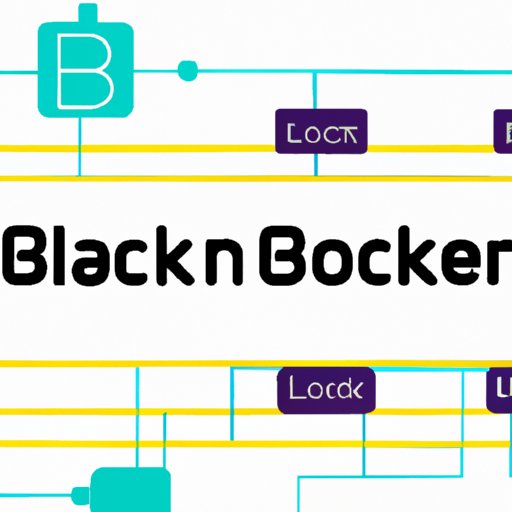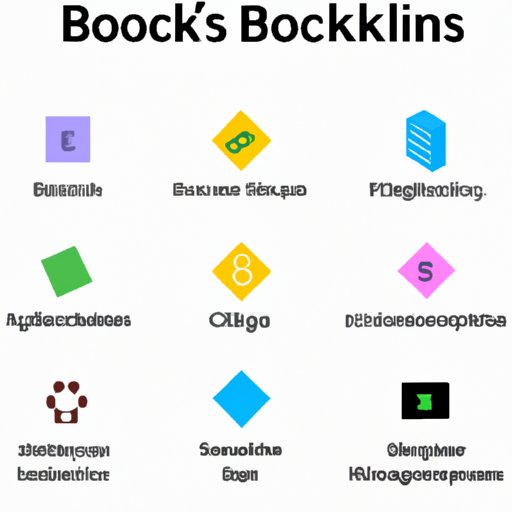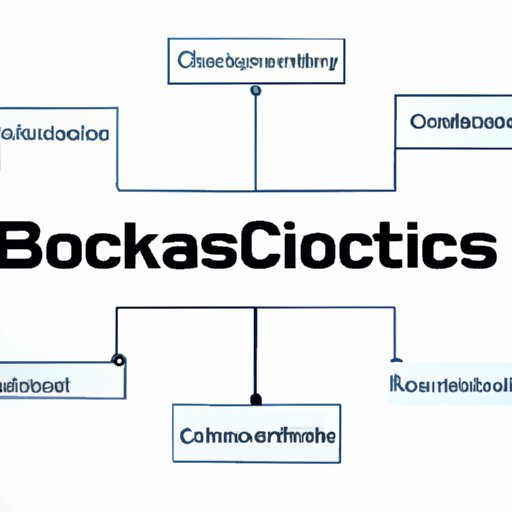Introduction
Blockchain programming is a relatively new concept that has become increasingly popular in recent years. It is a form of software engineering that uses a combination of distributed ledger technology, smart contracts, and cryptography to create secure, immutable digital records. In this article, we will explore what blockchain programming is, the basics of it, and the popular use cases for it.

Exploring the Basics of Blockchain Programming
Before diving into the specifics of blockchain programming, it is important to understand the basics of the technology. To do this, we must first define distributed ledger technology (DLT), smart contracts, and cryptography.
What is Distributed Ledger Technology?
Distributed ledger technology is a type of database architecture that is used to store and manage digital records. Unlike traditional databases, DLTs are distributed across multiple computers or nodes, which makes them more secure and resilient. DLTs are often used to power blockchain networks and cryptocurrencies, as they enable users to securely transfer digital assets without the need for a third-party intermediary.
What are Smart Contracts?
Smart contracts are self-executing contracts that are written in code and stored on a blockchain network. They allow users to exchange money, property, shares, or anything of value in a transparent, conflict-free way while avoiding the services of a middleman. Smart contracts are powered by blockchain technology and are designed to be immutable, meaning that once they are created, they cannot be changed or deleted. This ensures that all parties involved in the contract agree to the same terms and conditions.
How Does Cryptography Play a Role in Blockchain Programming?
Cryptography is the science of encoding and decoding information in order to protect it from unauthorized access. In the context of blockchain programming, cryptography is used to ensure that data stored on the blockchain is secure and tamper-proof. Cryptography also enables users to securely transfer digital assets without the need for a third-party intermediary.

An Overview of Blockchain Programming Languages
There are several programming languages that are commonly used for blockchain programming. These include Solidity, Simplicity, Viper, C++, and Rust. Each language has its own advantages and disadvantages, so it is important to consider which language is best suited for your project.
Commonly Used Languages
Solidity is a programming language that was specifically designed for writing smart contracts on the Ethereum blockchain. It is a high-level language with a syntax similar to JavaScript, making it easy to learn and use. Simplicity is another language that is designed for writing smart contracts on the Ethereum blockchain. It is a low-level language designed to make it easier to write secure and reliable smart contracts. Viper is a Python-based language that is designed for writing smart contracts on the Ethereum blockchain. It is a high-level language that is designed to make it easier to write secure and reliable smart contracts. C++ is an object-oriented language that is commonly used for developing blockchain applications. Finally, Rust is a memory-safe language that is designed for developing blockchain applications.
Advantages and Disadvantages of Each Language
Each language has its own advantages and disadvantages. Solidity is designed to make it easier to write secure and reliable smart contracts, but it can be difficult to debug. Simplicity is designed to make it easier to write secure and reliable smart contracts, but it can be difficult to read. Viper is designed to make it easier to write secure and reliable smart contracts, but it can be difficult to debug. C++ is a powerful language that is well-suited for developing blockchain applications, but it can be difficult to learn. Finally, Rust is a memory-safe language that is designed for developing blockchain applications, but it can be difficult to debug.

Understanding Distributed Ledger Technology and Its Role in Blockchain Programming
As mentioned earlier, distributed ledger technology is a type of database architecture that is used to store and manage digital records. It is an essential component of blockchain programming, as it enables users to securely transfer digital assets without the need for a third-party intermediary.
What is Distributed Ledger Technology?
Distributed ledger technology is a type of database architecture that is used to store and manage digital records. It is based on distributed computing systems, which means that the data is not stored in a single location but is instead spread out across multiple computers or nodes. This makes it more secure and resilient than traditional databases.
Benefits of Distributed Ledger Technology
The primary benefit of distributed ledger technology is that it is more secure and resilient than traditional databases. Additionally, it enables users to securely transfer digital assets without the need for a third-party intermediary. Furthermore, distributed ledger technology can be used to create trustless systems, which can help reduce fraud and increase transparency.
Challenges of Distributed Ledger Technology
One of the main challenges of distributed ledger technology is scalability. As more users join the network, it becomes more difficult to process transactions in a timely manner. Additionally, distributed ledger technology requires a large amount of energy to function, which can be costly. Finally, distributed ledger technology is still relatively new and there are not many experts who are familiar with the technology.
A Guide to Smart Contracts and How They Impact Blockchain Programming
Smart contracts are self-executing contracts that are written in code and stored on a blockchain network. They are an essential component of blockchain programming, as they enable users to securely transfer digital assets without the need for a third-party intermediary.
What are Smart Contracts?
Smart contracts are self-executing contracts that are written in code and stored on a blockchain network. They are powered by blockchain technology and are designed to be immutable, meaning that once they are created, they cannot be changed or deleted. This ensures that all parties involved in the contract agree to the same terms and conditions.
Benefits of Smart Contracts
The primary benefit of smart contracts is that they enable users to securely transfer digital assets without the need for a third-party intermediary. Additionally, smart contracts are immutable, meaning that once they are created, they cannot be changed or deleted. This ensures that all parties involved in the contract agree to the same terms and conditions. Finally, smart contracts can automate tedious tasks and streamline business processes.
Challenges of Smart Contracts
One of the main challenges of smart contracts is that they are vulnerable to malicious attacks, as they are written in code and stored on a blockchain network. Additionally, smart contracts can be difficult to debug, as they are written in code. Finally, smart contracts are still relatively new and there are not many experts who are familiar with the technology.
How Does Cryptography Play a Role in Blockchain Programming?
Cryptography is the science of encoding and decoding information in order to protect it from unauthorized access. In the context of blockchain programming, cryptography is used to ensure that data stored on the blockchain is secure and tamper-proof. Cryptography also enables users to securely transfer digital assets without the need for a third-party intermediary.
What is Cryptography?
Cryptography is the science of encoding and decoding information in order to protect it from unauthorized access. It is used to ensure the confidentiality, integrity, and authenticity of data. Cryptography is used in many different areas, including internet security and banking.
Benefits of Cryptography
The primary benefit of cryptography is that it enables users to securely transfer digital assets without the need for a third-party intermediary. Additionally, cryptography ensures that data stored on the blockchain is secure and tamper-proof. Finally, cryptography can be used to create trustless systems, which can help reduce fraud and increase transparency.
Challenges of Cryptography
One of the main challenges of cryptography is that it can be difficult to implement correctly. Additionally, cryptography requires a large amount of energy to function, which can be costly. Finally, cryptography is still relatively new and there are not many experts who are familiar with the technology.
Popular Use Cases for Blockchain Programming
Blockchain programming can be used in many different industries and for many different purposes. Some of the most popular use cases for blockchain programming include financial services, supply chain management, healthcare, and government.
Financial Services
Blockchain technology can be used to create secure and transparent financial systems. For example, blockchain technology can be used to facilitate payments, settlements, and trading of financial assets. Additionally, blockchain technology can be used to create digital currencies, such as Bitcoin.
Supply Chain Management
Blockchain technology can be used to improve supply chain management by creating secure and transparent systems. For example, blockchain technology can be used to track the movement of goods and to verify the authenticity of products. Additionally, blockchain technology can be used to automate tedious tasks, such as invoicing and payments.
Healthcare
Blockchain technology can be used to create secure and transparent healthcare systems. For example, blockchain technology can be used to store and share medical records in a secure and private manner. Additionally, blockchain technology can be used to automate tedious tasks, such as billing and payments.
Government
Blockchain technology can be used to create secure and transparent government systems. For example, blockchain technology can be used to create digital voting systems and to securely store and share government records. Additionally, blockchain technology can be used to automate tedious tasks, such as tax filing.
Conclusion
In conclusion, blockchain programming is a form of software engineering that uses a combination of distributed ledger technology, smart contracts, and cryptography to create secure, immutable digital records. There are several programming languages that are commonly used for blockchain programming, such as Solidity, Simplicity, Viper, C++, and Rust. Additionally, distributed ledger technology, smart contracts, and cryptography are all essential components of blockchain programming. Finally, blockchain programming can be used in many different industries, such as financial services, supply chain management, healthcare, and government.
Summary of Key Points
Blockchain programming is a form of software engineering that uses a combination of distributed ledger technology, smart contracts, and cryptography to create secure, immutable digital records. There are several programming languages that are commonly used for blockchain programming, and distributed ledger technology, smart contracts, and cryptography are all essential components of blockchain programming. Additionally, blockchain programming can be used in many different industries, such as financial services, supply chain management, healthcare, and government.
Final Thoughts
Blockchain programming is a rapidly evolving field that has the potential to revolutionize many different industries. By understanding the basics of blockchain programming, you can gain a better understanding of how it works and how it can be used to create secure and transparent systems. Additionally, by exploring the popular use cases for blockchain programming, you can gain insights into how it can be used in various industries.
(Note: Is this article not meeting your expectations? Do you have knowledge or insights to share? Unlock new opportunities and expand your reach by joining our authors team. Click Registration to join us and share your expertise with our readers.)
